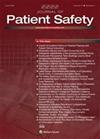Increased Risk and Unique Clinical Course of Patient Safety Indicator-3 Pressure Injuries Among COVID-19 Hospitalized Patients.
IF 1.7
3区 医学
Q3 HEALTH CARE SCIENCES & SERVICES
引用次数: 0
Abstract
BACKGROUND The COVID-19 pandemic introduced unique challenges to healthcare systems, particularly in relation to patient safety and adverse events during hospitalization. There is limited understanding of COVID-19's association with some patient safety indicators (PSIs). OBJECTIVES This study aimed to investigate the impact of COVID-19 infection on the rate of PSI-3 events and its implications on quality metrics. We compared PSI-3 event rates between COVID-19-infected and uninfected patients and examined the clinical characteristics of COVID-19 patients experiencing PSI-3 events. METHODS This is a retrospective study at Mayo Clinic hospitals between January 2020 and February 2022, analyzing patients meeting PSI-3 denominator eligibility criteria. PSI-3 events were identified using AHRQ WinQI software. Patients were categorized based on COVID-19 status. Patient demographics, characteristics, and PSI-3 rates were compared. A case series analysis described clinical details of COVID-19 patients with PSI-3 events. RESULTS Of 126,781 encounters meeting PSI-3 criteria, 8674 (6.8%) had acute COVID-19 infection. COVID-19-infected patients were older, more likely to be male, non-white, and had private insurance. PSI-3 rates were significantly higher in COVID-19 patients (0.21% versus 0.06%, P < 0.0001), even after risk adjustment (adjusted risk ratio, 3.24, P < 0.0001). The case series of 17 COVID-19 patients with PSI-3 events showed distinctive clinical characteristics, including higher medical device-related pressure injuries, and greater predisposition for head, face, and neck region. CONCLUSIONS Acute COVID-19 infection correlates with higher PSI-3 event rates. Current quality indicators may require adaptation to address the pandemic's complexities and impact on patient safety. Further research is needed to comprehensively understand the intricate relationship between COVID-19 and patient outcomes.在 COVID-19 住院患者中,患者安全指标-3 压力伤的风险增加和独特的临床过程。
背景COVID-19大流行给医疗系统带来了独特的挑战,尤其是在患者安全和住院期间的不良事件方面。本研究旨在调查 COVID-19 感染对 PSI-3 事件发生率的影响及其对质量指标的影响。我们比较了感染 COVID-19 和未感染 COVID-19 患者的 PSI-3 事件发生率,并研究了发生 PSI-3 事件的 COVID-19 患者的临床特征。PSI-3 事件使用 AHRQ WinQI 软件进行识别。根据 COVID-19 状态对患者进行分类。比较了患者的人口统计学、特征和 PSI-3 发生率。病例系列分析描述了发生 PSI-3 事件的 COVID-19 患者的临床细节。结果在符合 PSI-3 标准的 126781 例患者中,有 8674 例(6.8%)急性 COVID-19 感染。感染 COVID-19 的患者年龄较大,更可能是男性、非白人,且有私人保险。COVID-19 患者的 PSI-3 感染率明显更高(0.21% 对 0.06%,P < 0.0001),即使经过风险调整后也是如此(调整后风险比为 3.24,P < 0.0001)。17例COVID-19患者中发生PSI-3事件的病例系列显示出独特的临床特征,包括较高的医疗设备相关压力损伤,以及较高的头面部和颈部区域易感性。目前的质量指标可能需要进行调整,以应对大流行病的复杂性和对患者安全的影响。要全面了解 COVID-19 与患者预后之间错综复杂的关系,还需要进一步的研究。
本文章由计算机程序翻译,如有差异,请以英文原文为准。
求助全文
约1分钟内获得全文
求助全文
来源期刊

Journal of Patient Safety
HEALTH CARE SCIENCES & SERVICES-
CiteScore
4.60
自引率
13.60%
发文量
302
期刊介绍:
Journal of Patient Safety (ISSN 1549-8417; online ISSN 1549-8425) is dedicated to presenting research advances and field applications in every area of patient safety. While Journal of Patient Safety has a research emphasis, it also publishes articles describing near-miss opportunities, system modifications that are barriers to error, and the impact of regulatory changes on healthcare delivery. This mix of research and real-world findings makes Journal of Patient Safety a valuable resource across the breadth of health professions and from bench to bedside.
 求助内容:
求助内容: 应助结果提醒方式:
应助结果提醒方式:


